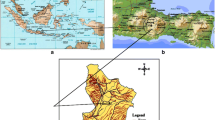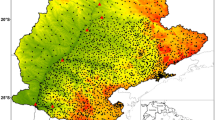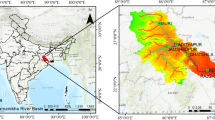Abstract
The present study assessed the hydrological response of land use land cover (LULC) change on the Punpun River basin. High-resolution gridded rainfall and temperature data from the years 1995 to 2020 have been used in the Soil and Water Assessment Tool (SWAT) in the Geographic Information System (GIS) to analyze the hydrological response of the Punpun River basin and water balance components. Hydrological Response Units (HRUs) have been created for the basin. Each HRU is based on a distinct combination of soil, slope, and land use. Five SWAT models have been prepared based on the LULC of every 5-year interval to simulate the basin’s hydrological response. The period selected for calibration is 1995–2015 and for validation is 2016–2020 for the modeling of daily streamflow data. The observed and simulated streamflow was checked for performance indices of coefficient of determination (R2), Nash–Sutcliffe Efficiency (NSE), and percent bias (PBIAS) on daily time steps. The results were found to be good with R2 = 0.72, NSE = 0.68, and PBIAS = 23.2 for calibration and R2 = 0.93, NSE = 0.77, and PBIAS = 19.8 for validation. The study reveals that 7.01% of evapotranspiration (ET) was increased from 1995 to 2020 with increase in agricultural area of 21.86%. It was also found that built-up area, surface runoff, and water yield have been increased by 9.14, 14.43, and 17.40%, respectively. Further, the groundwater contribution of the basin was decreased.











Similar content being viewed by others
Availability of data and materials
Some or all data that support the findings of this study are not available publicly; the reader should contact the corresponding author for details.
References
Abbaspour, K. C., Rouholahnejad, E., Vaghefi, S. B., Srinivasan, R., Yang, H., & Kløve, B. (2015). A continental-scale hydrology and water quality model for Europe: Calibration and uncertainty of a high-resolution large-scale SWAT model. Journal of Hydrology, 524, 733–752.
Abbaspour, K. C., Yang, J., Maximov, I., Siber, R., Bogner, K., Mieleitner, J., & Srinivasan, R. (2007). Modelling hydrology and water quality in the pre-alpine/alpine Thur watershed using SWAT. Journal of Hydrology, 333(2–4), 413–430.
Aghsaei, H., Dinan, N. M., Moridi, A., Asadolahi, Z., Delavar, M., Fohrer, N., & Wagner, P. D. (2020). Effects of dynamic land use/land cover change on water resources and sediment yield in the Anzali wetland catchment, Gilan, Iran. Science of The Total Environment, 712, 136449.
Akoko, G., Le, T. H., Gomi, T., & Kato, T. (2021). A Review of SWAT Model Application in Africa. Water, 13, 1313. https://doi.org/10.3390/w13091313
Arnold, J. G., Srinivasan, R., Muttiah, R. S., & Williams, J. R. (1998). Large area hydrologic modeling and assessment part I: model development 1. JAWRA Journal of the American Water Resources Association, 34(1), 73-89.
Ayivi, F., & Jha, M. K. (2018). Estimation of water balance and water yield in the Reedy Fork-Buffalo Creek Watershed in North Carolina using SWAT. International Soil and Water Conservation Research, 6, 203–213.
Baker, T. J., & Miller, S. E. (2013). Using the Soil and Water Assessment Tool (SWAT) to assess land use impact on water resources in an east African watershed. Journal of Hydrology, 486, 100–111.
Butt, A., Shabbir, R., Ahmad, S. S., & Aziz, N. (2015). Land use change mapping and analysis using remote sensing and GIS: A case study of Simly watershed, Islamabad, Pakistan. Egyptian Journal of Remote Sensing and Space Science, 18(2), 251–259.
Cao, W., Bowden, W. B., & Davie, T. (2009). Modelling impacts of land cover change on critical water resources in the Motueka River catchment, New Zealand. Water Resource Management, 23, 137–151.
Chu, M. L., Knouft, J. H., Ghulam, A., Guzman, J. A., & Pan, Z. (2013). Impacts of urbanization on river flow frequency: A controlled experimental modeling-based evaluation approach. Journal of Hydrology, 495, 1–12.
Costa, M. H., Botta, A., & Cardille, J. A. (2003). Effects of large-scale changes in land cover on the discharge of the Tocantins River, Amazonia. Journal of Hydrology, 283, 206–217.
de Oliveira Serrão, E. A., Silva, M. T., Ferreira, T. R., de Ataide, L. C. P., dos Santos, C. A., de Lima, A. M. M., ... & Gomes, D. J. C. (2022). Impacts of land use and land cover changes on hydrological processes and sediment yield determined using the SWAT model. International Journal of Sediment Research, 37(1), 54-69.
Engida, T., Nigussie, T. A., Aneseyee, A. B., & Barnabas, J. (2021). Land use/land cover change impact on hydrological process in the Upper Baro Basin, Ethiopia. Applied and Environmental Soil Science, Article ID, 6617541, 1–15. https://doi.org/10.1155/2021/6617541
Gassman, P. W., Sadeghi, A. M., & Srinivasan, R. (2014). Applications of the SWAT model special section: Overview and insights. Journal of Environmental Quality, 43(1), 1–8. https://doi.org/10.2134/jeq2013.11.0466
Güler, M., Yomralioǧu, T., & Reis, S. (2007). Using Landsat data to determine land use/land cover changes in Samsun. Turkey. Environmental Monitoring and Assessment, 127(1–3), 155–167.
Hahmann, A. N., & Dickinson, R. E. (1997). RCCM2-BATS model over tropical South America: Application to tropical deforestation. Journal of Climate, 10, 1944–1964.
Iban, M. C., & Sahin, E. (2022). Monitoring land use and land cover change near a nuclear power plant construction site: Akkuyu case. Turkey. Environmental Monitoring and Assessment, 194, 724.
Imam, S. (2021). Population growth and urbanization in Bihar: A district level analysis. International Journal of Science and Research (IJSR), 10(8), 606–614.
Kundu, S., Khare, D., & Mondal, A. (2017). Past, present and future land use changes and their impact on water balance. Journal of Environmental Management, 197, 582–596.
Lee, S. J., & Berbery, E. H. (2012). Land cover change effects on the climate of the La Plata Basin. Journal of Hydrometeorology, 13(1), 84–102.
Mahmood, R., Pielke, R. A., Hubbard, K. G., Niyogi, D., Dirmeyer, P. A., Mcalpine, C., Carleton, A. M., Hale, R., Gameda, S., Beltrán-Przekurat, A., Baker, B., Mcnider, R., Legates, D. R., Shepherd, M., Du, J., Blanken, P. D., Frauenfeld, O. W., Nair, U. S., & Fall, S. (2014). Land cover changes and their biogeophysical effects on climate. International Journal of Climatology, 34(4), 929–953.
Marland, G. (2003). The climatic impacts of land surface change and carbon management, and the implications for climate-change mitigation policy. Climate Policy, 3, 149–157.
Matheussen, B., Kirschbaum, R. L., Goodman, I. A., O’Donnell, G. M., & Lettenmaier, D. P. (2000). Effects of land cover change on streamflow in the interior Columbia River Basin (USA and Canada). Hydrological Processes, 14, 867–885.
Moriasi, D., Arnold, J., Van Liew, M., Bingner, R., Harmel, R. D., & Veith, T. (2007). Model evaluation guidelines for systematic quantification of accuracy in water-shed simulations. Transactions of the ASABE, 50(3), 885–900.
Munoth, P., & Goyal, R. (2019). Impacts of land use land cover change on runoff and sediment yield of Upper Tapi River Sub-Basin. India, International Journal of River Basin Management,. https://doi.org/10.1080/15715124.2019.1613413
Napoli, M., Massetti, L., & Orlandini, S. (2017). Hydrological response to land use and climate changes in a rural hilly basin in Italy. CATENA, 157, 1–11.
Nobre, C. A., Sellers, P. J., & Shukla, J. (1991). Amazonian deforestation and regional climate change. Journal of Climate, 4, 957–988.
Panda, D. K., & Wahr, J. (2016). Spatiotemporal evolution of waterstorage changes in India from theupdated GRACE-derived gravityrecords, Water Resour. Res., 52, 135–149. https://doi.org/10.1002/2015WR017797
Pielke, R., Sr., Nielsen-Gammon, J., Davey, C., Angel, J., Bliss, O., Doesken, N., Cai, M., Fall, S., Niyogi, D., Gallo, K., Hale, R., Hubbard, K. G., Lin, X., Li, H., & Raman, S. (2007). Documentation of uncertainties and biases associated with surface temperature measurement sites for climate change assessment. Bulletin of the American Meteorological Society, 88(6), 913–928.
Pignotti, G., Rathjens, H., Cibin, R., Chaubey, I., & Crawford, M. (2017). Comparative analysis of HRU and grid-based SWAT models. Water, 9, 272. https://doi.org/10.3390/w9040272
Pitman, A. J. (2003). The evolution of, and revolution in, land surface schemes designed for climate models. International Journal of Climatology, 23, 479–510.
Ranjan, S., & Singh, V. (2022). HEC-HMS based rainfall-runoff model for Punpun River basin. Water Practice and Technology, 17(5), 986–1001.
Ranjan, S., & Singh, V. (2023). ANN and GRNN-based coupled model for flood inundation mapping of the Punpun River basin. Eng. Technol. Appl. Sci. Res., 13(1), 9941–9946.
Rautela, K. S., Kumar, M., Sofi, M. S., Kuniyal, J. C., & Bhat, S. U. (2022). Modelling of streamflow and water balance in the kuttiyadi River Basin using SWAT and remote sensing/GIS tools. International Journal of Environmental Research, 16(4), 1–14.
Rautela, K. S., Kumar, D., Gandhi, B. G. R., Kumar, A., & Dubey, A. K. (2023). Long-term hydrological simulation for the estimation of snowmelt contribution of Alaknanda River Basin, Uttarakhand using SWAT. Journal of Water Supply: Research and Technology-Aqua, 72(2), 139–159.
Saddique, N., Mahmood, T., & Bernhofer, C. (2020). Quantifying the impacts of land use/land cover change on the water balance in the afforested River Basin. Pakistan. Environ Earth Sci, 79, 448. https://doi.org/10.1007/s12665-020-09206-w
Sam, T. T., & Khoi, D. N. (2022). The responses of river discharge and sediment load to historical land-use/land-cover change in the Mekong River Basin. Environmental Monitoring and Assessment, 194, 700.
Schilling, K. E., Jha, M. K., Zhang, Y. K., Gassman, P. W., & Wolter, C. F. (2008). Impact of land use and land cover change on the water balance of a large agricultural watershed: Historical effects and future directions. Water Resources Research, 44, 1–12.
Sertel, E., Robock, A., & Ormeci, C. (2010). Impacts of land cover data quality on regional climate simulations. International Journal of Climatology, 30, 1942–1953.
Sinha, R. K., Eldho, T. I., & Ghosh, S. (2020). Assessing the impacts of land cover and climate on runoff and sediment yield of a river basin. Hydrological Sciences Journal, 65, 2097–2115.
Subramanya, K. (2013). “Engineering hydrology”, McGraw Hill Education Private Limited, Fourth Edition, New Delhi.
Sy, S., Noblet-Ducoudré, N. D., Quesada, B., Sy, I., Dieye, A. M., Gaye, A. T., & Sultan, B. (2017). Land-surface characteristics and climate in West Africa: Models’ biases and impacts of historical anthropogenically-induced deforestation. Sustainability, MDPI, 9(10), 1917.
Thokchom, B. (2020). Water-related problem with special reference to global climate change in India. Water Conservation and Wastewater Treatment in BRICS Nations, Elsevier, 37–60.
Wang, Y., Jiang, R., Xie, J., Zhao, Y., Yan, D., & Yang, S. (2019). Soil and water assessment tool (SWAT) model: A systemic review. In: Guido-Aldana, P.A. and Mulahasan, S. (eds.), Advances in Water Resources and Exploration. Journal of Coastal Research, Special Issue No. 93, pp. 22–30. Coconut Creek (Florida), ISSN 0749–0208.
Wei, X., & Zhang, M. (2010). Quantifying streamflow change caused by forest disturbance at a large spatial scale: A single watershed study. Water Resources Research, 46, W12525.
Yan, R., Zhang, X., Yan, S., Zhang, J., & Chen, H. (2018). Spatial patterns of hydrological responses to land use/cover change in a catchment on the Loess Plateau, China. Ecological Indicators, 92, 151–160.
Zhang, L., Karthikeyan, R., Bai, Z., & Srinivasan, R. (2017). Analysis of streamflow responses to climate variability and land use change in the Loess Plateau region of China. CATENA, 154, 1–11.
Zou, M., Niu, J., Kang, S., Li, X., & Hongna, Lu. (2017). The contribution of human agricultural activities to increasing evapotranspiration is significantly greater than climate change effect over Heihe agricultural region. Science and Reports, 7, 8805. https://doi.org/10.1038/s41598-017-08952-5
Acknowledgements
The authors are thankful to Central Water Commission (CWC) Patna for providing the river discharge data and other online sources such as NASA Agro Climate Data, USGS Earth Explorer, and FAO Soil Map that are used for carrying out this research work.
Author information
Authors and Affiliations
Contributions
Shashi Ranjan: literature review, conceptualization, methodology, modeling, result analysis, conclusion, and writing the original manuscript. Vivekanand Singh: conceptualization, supervision/guidance, and reviewed original manuscript.
Corresponding author
Ethics declarations
Ethical Standards
All authors have read, understood, and have complied as applicable with the statement on “Ethical responsibilities of Authors” as found in the Instructions for Authors and are aware that with minor exceptions, no changes can be made to authorship once the paper is submitted.
Competing interests
The authors declare no competing interests.
Additional information
Publisher's Note
Springer Nature remains neutral with regard to jurisdictional claims in published maps and institutional affiliations.
Rights and permissions
Springer Nature or its licensor (e.g. a society or other partner) holds exclusive rights to this article under a publishing agreement with the author(s) or other rightsholder(s); author self-archiving of the accepted manuscript version of this article is solely governed by the terms of such publishing agreement and applicable law.
About this article
Cite this article
Ranjan, S., Singh, V. Effect of land use land cover changes on hydrological response of Punpun River basin. Environ Monit Assess 195, 1137 (2023). https://doi.org/10.1007/s10661-023-11785-7
Received:
Accepted:
Published:
DOI: https://doi.org/10.1007/s10661-023-11785-7




